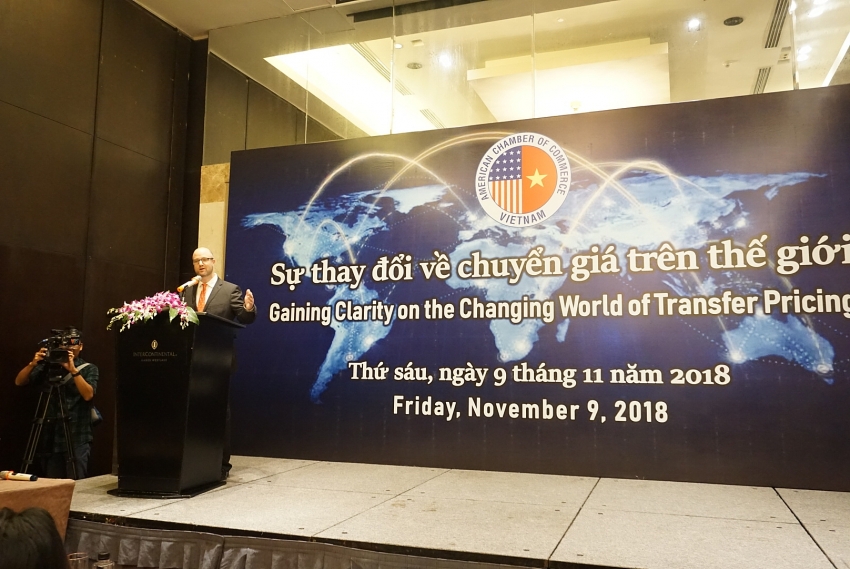Expert opinion: transfer pricing not necessarily illegal activity
 |
| Executive director of AmCham Adam Sitkoff at the workshop of transfer pricing |
In the morning of November 9 the American Chamber of Commerce (AmCham) organised a workshop on "gaining clarity on the changing world of transfer pricing" to discuss and learn about the rules and methodologies of transfer pricing, which is a hot topic right now.
At the workshop, Wayne Barford, senior advisor of International Tax and Investment Center, defined the rules and methods of pricing transactions within and between enterprises under common ownership or control.
Because of the potential for controlled cross-border transactions to distort taxable income, tax authorities in many countries adjust transfer prices that differ from what would have been charged by an unrelated enterprise dealing at arms' length.
As a result, in Wayne's opinion, "transfer pricing is not, in itself, illegal or necessarily abusive. What is illegal or abusive is transfer mispricing, also known as transfer pricing manipulation or abusive transfer pricing."
Executive director of AmCham Adam Sitkoff was also concerned about the overall assessment of transfer pricing as a way for tax evasion and an illegal activity.
The significant increase in the volume of cross-border transactions, the growth in national budget deficits, and the inaccurate media use of transfer pricing as a tax avoidance practice are creating challenges for multinational corporations for which cross-border transactions are simply an everyday business necessity. There are many misperceptions about transfer pricing in Vietnam, which is caused by a lack of knowledge of international norms and international business practices.
"Governments need to push money into the state budget and provide infrastructure and services to serve the country's people. Thereby, tax policy needs to be carefully considered, and most importantly tax collection and inspections need to be enforced fairly and equally," said Sitkoff.
In order to identify transfer pricing, the OECD (Organisation for Economic Co-operation and Development) has defined the arm's length principle. Accordingly, where conditions are made or imposed between the two associated enterprises in their commercial or financial relations which differ from those which would be made between independent enterprises, any profits which would, but for those conditions, have occurred to one of those enterprises, but by reason of those conditions have not so accrued may be included in the profits of that enterprise and taxed accordingly.
The arm's length approach includes providing broad parity of tax treatment, putting associated and independent enterprises on a more equal footing for tax purposes, avoiding the creation of tax advantages or disadvantages, removing tax consideration from economic decisions, promoting the growth of international trade and investment.
Wayne Barford pointed out four methods of transfer pricing. Under the comparable uncontrolled price method, the price of property or services transferred in a controlled transaction will compare to the price charged for property or services transferred in a comparable uncontrolled transaction in comparable circumstances.
The retail price method is based on the price at which a product that has been purchased from an associated enterprise is resold to an independent enterprise. The cost plus method uses the costs incurred by the supplier of property or services in a controlled transaction, appropriate cost plus mark-up is added to the cost to make an appropriate profit, and its result may be regarded as an arm’s length price of the original controlled transaction.
The transactional profits method will examine the profits that arise from particular controlled transactions of one or more of the associated enterprises participating in those transactions.
OECD members have developed the Action Programme Base Erosion and Profit Shifting (BEPS), which has been put into Decree 20/2017/ND-CP prescribing tax administration for enterprises engaged in transfer pricing since May 2017 with similar terms.
Another expert, Huong Vu, deputy director general of Ernst & Young Vietnam, also made clear the concept of transfer pricing, price of transfer and market price, as well as the development of the Vietnamese legal system from Circular No.117/2005/TT-BTC and Circular No.66/2010/TT-BTC on transfer pricing to Decree No.20/2017/ND-CP and Circular No.41/2017/TT-BTC on transfer pricing, along with the introduction of the annual transfer pricing disclosure form and transfer pricing documentation.
Currently, transfer pricing activities must comply with the terms of Decree 20 and Circular 41. She also outlined the differences between "abuse of transfer pricing to transfer profits" and "transfer pricing compliant with Vietnamese legal regulations and international practices."
What the stars mean:
★ Poor ★ ★ Promising ★★★ Good ★★★★ Very good ★★★★★ Exceptional
Related Contents
Latest News
More News
- Long-term capital seen as key hurdle to green growth (December 16, 2025 | 08:00)
- Gold prices swing amid tax debate and import uncertainty (December 15, 2025 | 18:04)
- Agribank frames bank credit as catalyst for green growth (December 15, 2025 | 17:59)
- Vietnam’s green transition demands collective financial action (December 15, 2025 | 12:00)
- VIR workshop highlights capital and policy for sustainable development (December 15, 2025 | 11:00)
- Promoting digital assets initiative in Vietnam (December 13, 2025 | 09:30)
- Experts flag gaps as national financial strategy under review (December 12, 2025 | 15:13)
- Global gold exchange models offer roadmap for Vietnamese market (December 12, 2025 | 11:58)
- Five million household businesses to adopt self-declared tax system (December 11, 2025 | 18:13)
- Vietnam establishes management board for crypto asset trading market (December 11, 2025 | 18:11)

 Tag:
Tag:




























 Mobile Version
Mobile Version